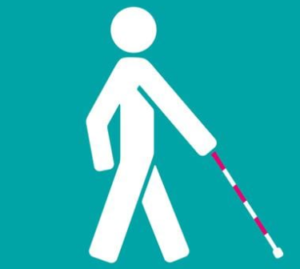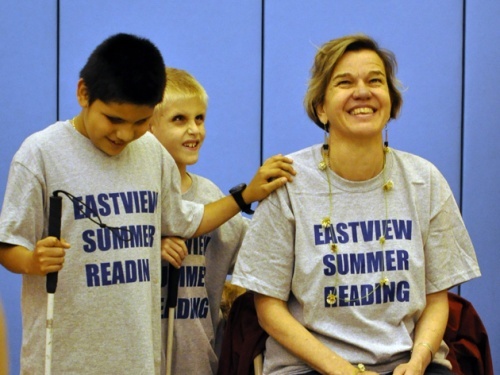Why Learn White Cane Skills Before Training with a Seeing Eye Dog?
by Beth
 With so many elementary school children learning at home these days, my Seeing Eye dog and I haven’t made a school visit in months. I miss being with the kids, but time off gives me a chance to reminisce about visits we’d done in the past. Learning that today, October 15, is National White Cane Safety Day made me think back on a day I especially enjoyed at Eastview Elementary School in Algonquin, IL long before the pandemic hit.
With so many elementary school children learning at home these days, my Seeing Eye dog and I haven’t made a school visit in months. I miss being with the kids, but time off gives me a chance to reminisce about visits we’d done in the past. Learning that today, October 15, is National White Cane Safety Day made me think back on a day I especially enjoyed at Eastview Elementary School in Algonquin, IL long before the pandemic hit.
When I found out that three students at Eastview were blind, I arranged to have Braille copies of my children’s book, Safe & Sound sent there before our visit. I’d use one myself to show the kids at different grade levels what Braille looks like and how it works, and the other three copies would be given to Miguel, age 10, and Seth and Ethan, both age 8. I didn’t expect that these three little blind kids would be able to read the Braille books on their own, I just thought that if the other kids at Eastview might be getting books, these three should get a copy they’d be able to read someday, too.
The Braille version of Safe & Sound was produced in contracted Braille, a form of Braille I’ve never been able to master. Contracted Braille has a bunch of shorthand symbols (contractions) for commonly used words and parts of words: there’s a cell for the word “and,” another for the word “the,” and so on. Most of the letters of the alphabet are also used as shorthand for common words, such as “c” for “can” and “l” for “like.” Kind of like texting, only you can’t make as many mistakes!
When I met the vision teacher at Eastview, I apologized that my book was only available in contracted Braille. “No problem,” she said. “That’s the only Braille these guys read!” Sure enough, the little buggers were Braille experts.
Really, all the Eastview kids seemed to have a strong interest in reading. The school’s principal, Jim Zursin, emphasized reading with all the students, and with the help of his staff and the PTO, they were making sure reading wouldn’t end when summer began. Every child who participated in Eastview’s summer reading program and reached their goal would be marching in the Founders Day Parade that summer, each star reader wearing a sandwich board with a drawing of the cover of his or her favorite book on the front. “There’ll be hundreds of books marching down the street,” Mr. Zursin exclaimed. You didn’t have to be able to see to know there were stars in his eyes, just thinking about it. Kids who read that summer would be invited to a community pool party, too, where Mr. Zursin promised to jump off the high dive – with his clothes on!

That’s Miguel on the left and one of the twins in the center. Photo by Andi Butler, www.mrsbillustrations.com.
I’m pretty confident Seth, Ethan and Miguel marched in the parade that year. They’d be swimming at that pool party, too. They love to read, and turns out they can write in contracted Braille, too. Seth, Ethan and Miguel each wrote a poem for me, and they had to work hard to hold back their laughter as I stumbled through some of the contractions when I tried reading their work out loud. They were happy to help me through, and in the half hour the four of us were able to spend together in their vision resource room we became fast friends. Miguel showed me how his talking watch worked, and Ethan and Seth, twin brothers, counted off their favorite rides at Disney World. We all laughed at how other kids find Space Mountain so scary. It’s in the dark” we said. Big deal.
The boys had lots of questions about my Seeing Eye dog, and I told them that in order to train with a Seeing Eye dog you have to learn good orientation and mobility (white cane) skills first. “Knowing where you are by what you hear, how the ground feels, which way the wind is blowing – you’ll need those skills when you get a Seeing Eye dog, too,” I told them. You can’t train with a Seeing Eye dog until you’re 16 years old, so they had a lot of time to perfect their white cane skills before then. “The Seeing Eye wants you to get good with your white cane before you train with a dog. People who know orientation and mobility and can get around with a white cane are the ones who do best with Seeing Eye dogs.”
Later on one of their teachers expressed how glad she was that I’d said that. Apparently the boys hadn’t been using their white canes as much as they should. “Now they’ll have an incentive.”
Before I left their room, each boy proudly presented me with a special collar he had made for my Seeing Eye dog. “We strung the beads ourselves,” Seth said, proud of their work. The collars were made of ribbon, and in addition to the beads, each ribbon had a big bell on it, too. “That’s so you’ll always know where your dog is,” Miguel explained.
The three of them came up after the all-school assembly at the end of the day to say goodbye. When I reached out to shake Seth’s – or was it Ethan’s? – hand, I felt a rubber handle. He was using his white cane!







November 7th, 2020 at 12:39 am
Looking for grants to help get a wheelchair accessible van I have lost both my legs below the knee and I can’t get in and out of our truck any ideas